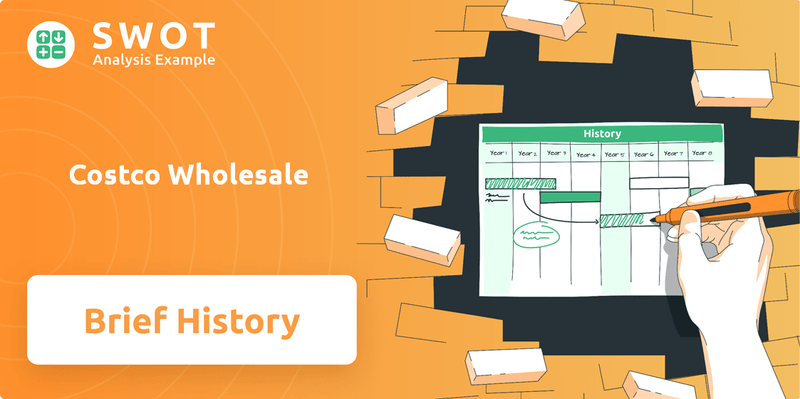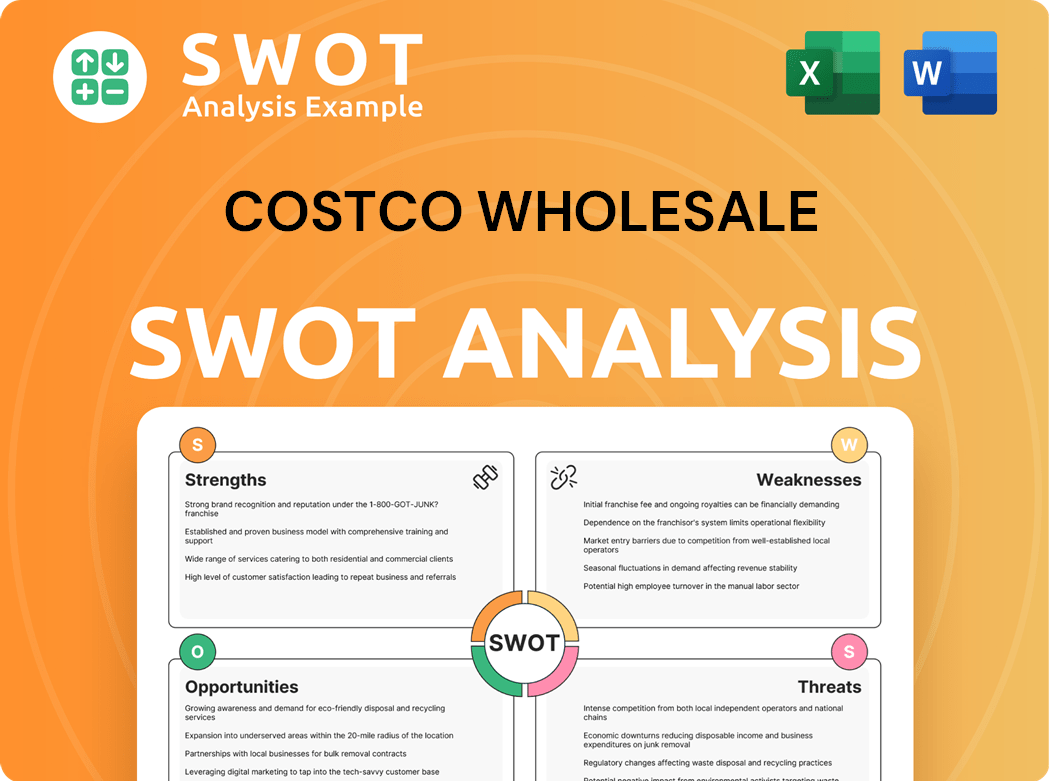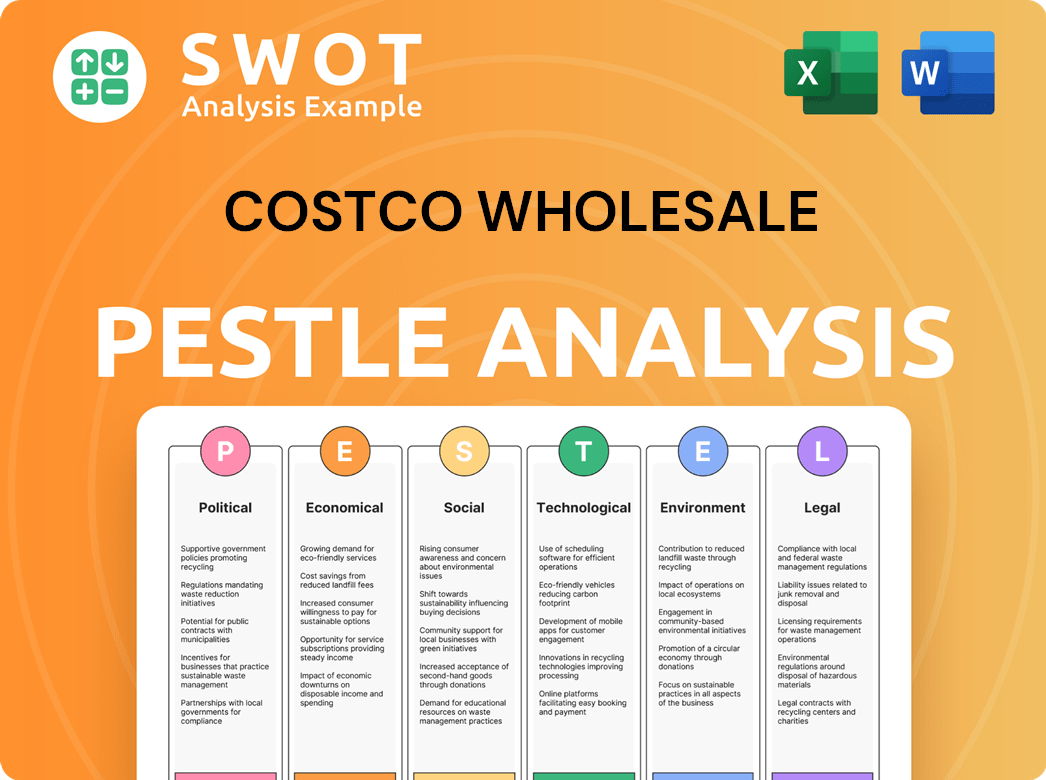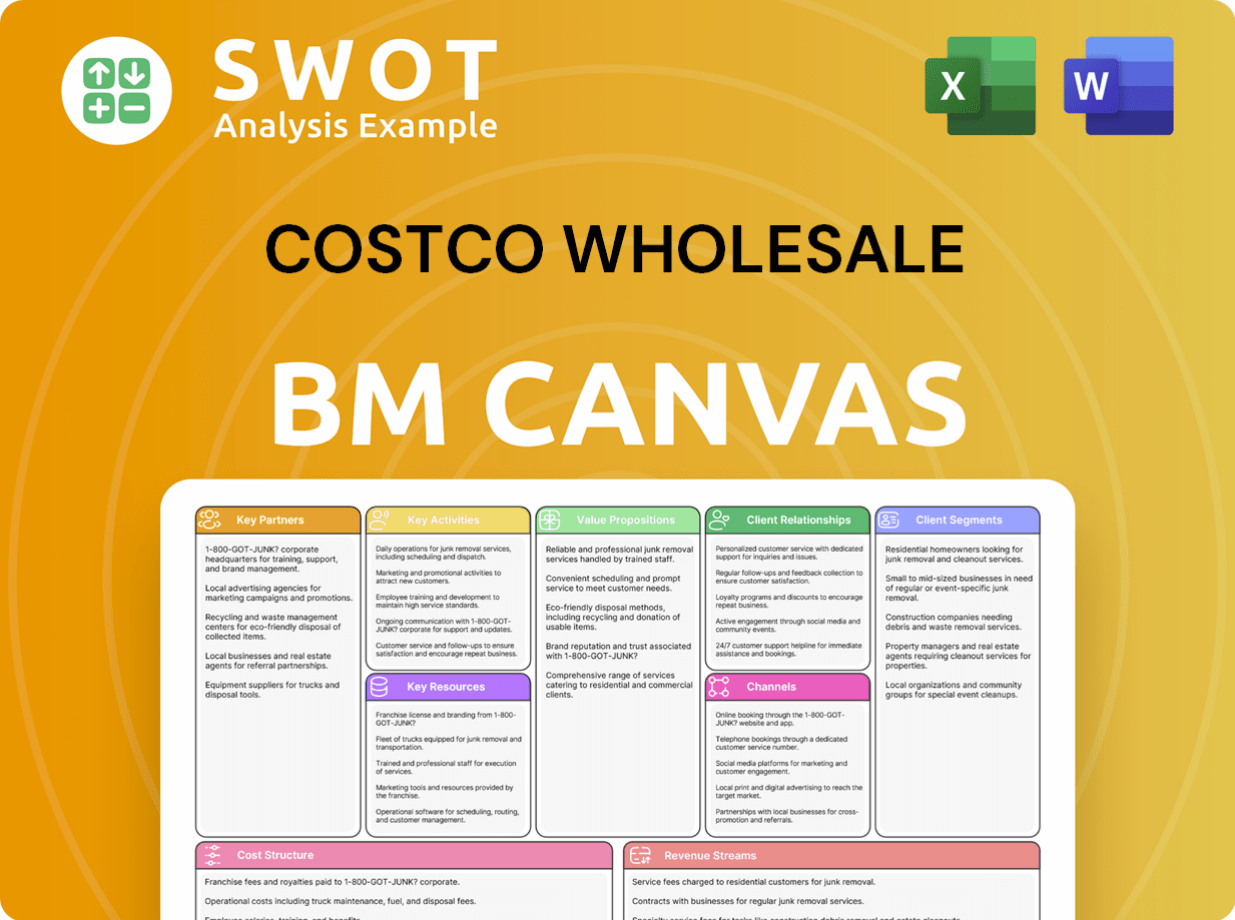Costco Wholesale Bundle
How did Costco Become a Retail Giant?
Costco Wholesale, a name synonymous with bulk buys and bargain prices, has a fascinating origin story. From its Costco Wholesale SWOT Analysis to its global presence, the company's journey is a testament to strategic innovation and customer-centric values. This article delves into the brief history of Costco, exploring its humble beginnings and remarkable evolution.

The Costco history began in 1983, but its roots trace back even further, revealing the vision of the Costco founders. Understanding the early days of Costco Wholesale, including its first location and the initial business model, is key to appreciating its subsequent expansion. This exploration of the Costco timeline will unveil how it transformed from a regional player to a global retail leader, impacting the industry along the way.
What is the Costco Wholesale Founding Story?
The story of Costco Wholesale Corporation, a retail giant, begins with the vision of James Sinegal and Jeffrey Brotman. The official founding date is September 15, 1983, in Seattle, Washington, but its roots trace back to earlier ventures. Sinegal, with his retail and wholesale background, saw an opportunity to create a membership-based warehouse club focused on value. Brotman, an attorney, co-founded the company, bringing strategic and legal expertise.
The goal was to provide small businesses and individuals with high-quality products at wholesale prices, avoiding traditional retail markups. Their initial business model involved an annual membership fee for access to a limited selection of bulk-sold products at low margins. This strategy aimed to drive high sales volumes and rapid inventory turnover. The initial merchandise catered to both business and individual needs, prioritizing value over extensive variety.
The name 'Costco' was chosen to reflect its focus on being a 'cost company,' emphasizing cost efficiency and passing savings to members. Funding came from founder capital and early investments, leveraging the founders' experience. This period was marked by the challenge of establishing a new retail concept and convincing consumers of the value proposition. The economic climate of the early 1980s, focused on efficiency, provided a favorable environment for Costco's emergence. To learn more about the company's core principles, you can read about the Mission, Vision & Core Values of Costco Wholesale.
Costco's origin is tied to James Sinegal and Jeffrey Brotman, who launched the company in 1983. They aimed to offer wholesale prices through a membership model.
- Costco history began in Seattle, Washington.
- The founders, Sinegal and Brotman, brought retail and legal expertise.
- The focus was on providing value and low prices to members.
- The business model included membership fees and bulk sales.
Costco Wholesale SWOT Analysis
- Complete SWOT Breakdown
- Fully Customizable
- Editable in Excel & Word
- Professional Formatting
- Investor-Ready Format

What Drove the Early Growth of Costco Wholesale?
The early growth of Costco Wholesale was marked by rapid expansion and a focus on refining its membership model. From its 1983 founding, the company quickly established a presence across the Pacific Northwest. This phase involved opening new warehouses designed for efficiency and emphasizing a curated selection of high-volume items. This approach resonated with both small business owners and individual consumers seeking bulk savings, setting the stage for future growth.
A key milestone in the Costco history was the 1993 merger with Price Club, forming Price/Costco Inc. This brought together two warehouse club pioneers, boosting market share and purchasing power. The combined entity, later renamed Costco Wholesale Corporation, leveraged strengths from both companies. This period also saw team expansion to manage warehouses and a growing supply chain.
Entry into new markets, both in the U.S. and internationally, was pivotal for Costco's expansion. The company established a presence in Canada and other international markets, demonstrating the global appeal of its business model. Early customer acquisition strategies focused on member satisfaction and targeted marketing. The company's growth metrics showed consistent increases in membership and revenue.
Leadership transitions, including the continued guidance of James Sinegal, played a crucial role in maintaining the company's strategic vision. Market reception was largely positive, as consumers recognized the value of the warehouse club format. Pivotal decisions during this period focused on optimizing inventory management and expanding the 'Kirkland Signature' private-label brand. The company's focus remained on low prices and high volume.
In 2024, Costco reported net sales of approximately $253.7 billion. The company's membership fees also contributed significantly to its revenue, with membership fees reaching around $4.6 billion in the same year. The company operates over 870 warehouses worldwide as of 2024, demonstrating its continued global expansion. These figures reflect the success of Costco Wholesale's early strategies.
Costco Wholesale PESTLE Analysis
- Covers All 6 PESTLE Categories
- No Research Needed – Save Hours of Work
- Built by Experts, Trusted by Consultants
- Instant Download, Ready to Use
- 100% Editable, Fully Customizable

What are the key Milestones in Costco Wholesale history?
The Costco history is marked by significant growth and strategic pivots since its Costco origin. From its humble beginnings, the company has expanded its footprint and diversified its offerings, becoming a major player in the retail industry. Understanding the Costco timeline reveals the key decisions and innovations that have shaped its success.
| Year | Milestone |
|---|---|
| 1976 | The first Price Club warehouse opened in a converted airplane hangar in San Diego, California, catering to small businesses. |
| 1983 | Costco founders James Sinegal and Jeffrey Brotman opened the first Costco Wholesale warehouse in Seattle, Washington. |
| 1993 | Price Club and Costco Wholesale merged, forming Price/Costco, which later became Costco Wholesale. |
| 1995 | The Costco launched its private-label brand, Kirkland Signature, which quickly became a significant part of its product offerings. |
| 2000s | Costco expanded internationally, opening warehouses in various countries, including Canada, Mexico, and the United Kingdom. |
| 2023 | Costco reported net sales of $242.2 billion for the fiscal year, a 6.9% increase compared to the previous year. |
One of the most impactful innovations was the introduction of the Kirkland Signature brand, offering high-quality products at competitive prices. This strategy enhanced member loyalty and provided Costco with greater control over its supply chain. Furthermore, the company's integration of various services, such as optical centers and gas stations, within its warehouses has set it apart from competitors, offering added value to its members.
The launch of Kirkland Signature in 1995 offered members high-quality products at lower prices, increasing member loyalty and providing control over product quality and pricing. This private-label brand became a cornerstone of Costco's strategy.
Costco pioneered offering a wide array of services within its warehouses, including optical centers, pharmacies, and gas stations. This approach provided additional value and convenience to its members, differentiating it from competitors.
The membership model, central to Costco's business strategy, ensures consistent revenue and fosters customer loyalty. This model allows Costco to offer lower prices on products.
Recognizing the shift in consumer shopping habits, Costco has steadily invested in its online presence to complement its physical stores. This strategic move helps to broaden its market reach.
Costco's focus on efficient operations and disciplined inventory management has been crucial to its success. This approach helps to keep costs low and maintain high-value offerings for members.
Costco's strategic expansion into international markets has been a key driver of its growth. This has allowed Costco to tap into new customer bases and increase its overall market share.
Despite its success, Costco has faced challenges, including economic downturns and increased competition from other retailers and e-commerce platforms. The company has also had to address issues related to its supply chain and ethical sourcing practices. Adapting to evolving consumer preferences and maintaining its commitment to member value remain ongoing priorities.
The 2008 financial crisis and subsequent economic downturns presented challenges to consumer spending, requiring Costco to adapt its inventory and pricing strategies. This required the company to maintain value and attract customers.
Competition from other large retailers and e-commerce giants has consistently pushed Costco to innovate and reinforce its unique value proposition. This competition requires continuous adaptation to stay relevant.
Managing its vast supply chain and ensuring ethical sourcing have been ongoing challenges for Costco. The company has addressed these issues through robust internal controls and transparency initiatives.
Adapting to changing consumer shopping habits and preferences is an ongoing challenge. Costco must continue to evolve its offerings to meet customer expectations.
Disciplined inventory management is crucial for Costco's success, helping to keep costs low and maintain high-value offerings for members. This includes the need to adapt to changing market trends.
Costco must continuously seek ways to enhance the member experience and maintain its value proposition. This includes offering competitive prices and a wide selection of quality products.
Costco Wholesale Business Model Canvas
- Complete 9-Block Business Model Canvas
- Effortlessly Communicate Your Business Strategy
- Investor-Ready BMC Format
- 100% Editable and Customizable
- Clear and Structured Layout

What is the Timeline of Key Events for Costco Wholesale?
The Costco history is a story of strategic growth and adaptation, beginning with its Costco origin in the 1970s. The company's journey, marked by key milestones and visionary leadership, has led it to become a retail giant. The Costco founders laid the groundwork for a unique business model that continues to resonate with consumers globally.
| Year | Key Event |
|---|---|
| 1976 | Sol Price opens the first Price Club in San Diego, California, setting the stage for the warehouse club concept. |
| 1983 | James Sinegal and Jeffrey Brotman open the first Costco Wholesale warehouse in Seattle, Washington, marking the official Costco timeline start. |
| 1985 | Costco goes public, providing capital for further expansion and growth. |
| 1993 | Costco Wholesale Corporation merges with Price Club, forming Price/Costco Inc., consolidating market presence. |
| 1995 | The Kirkland Signature private label brand is introduced, enhancing value for members. |
| 1997 | The company officially changes its name to Costco Wholesale Corporation, solidifying its brand identity. |
| 2000s | Significant Costco expansion into Asia and other global markets begins, broadening its international footprint. |
| 2004 | James Sinegal becomes sole CEO, guiding the company's strategic direction. |
| 2012 | Craig Jelinek takes over as CEO from James Sinegal, continuing the company's growth trajectory. |
| 2014 | Costco's revenue exceeds $100 billion, highlighting its substantial financial success. |
| 2020-2022 | Navigates supply chain challenges and increased demand during the global pandemic, demonstrating resilience. |
| 2023 | Celebrates 40 years of operations, reflecting its enduring presence in the retail sector. |
| 2024 | Continues strong membership growth and global expansion efforts, with a focus on enhancing its e-commerce capabilities. |
Costco is expected to continue its global expansion, especially in emerging markets. This strategy aims to tap into new customer bases and increase revenue streams. The company's international growth is a key element of its long-term strategy. In 2024, Costco operates in 14 countries, with plans for further expansion.
There's a strong focus on enhancing its e-commerce capabilities to provide a seamless omnichannel experience. This includes improving online shopping, delivery options, and overall customer experience. In fiscal year 2023, e-commerce sales represented approximately 8% of the company's total sales, indicating growth potential.
Innovation in product selection, particularly within the Kirkland Signature brand, is also anticipated. This includes introducing new products and expanding existing lines. The Kirkland Signature brand accounts for roughly 25% of Costco's total sales, making it a significant driver of growth.
The expansion of its service offerings is also a key area of focus. This includes adding new services like auto and home insurance. Costco's services contribute to membership value and increased customer loyalty. In 2024, the company continues to explore new service offerings to meet member needs.
Costco Wholesale Porter's Five Forces Analysis
- Covers All 5 Competitive Forces in Detail
- Structured for Consultants, Students, and Founders
- 100% Editable in Microsoft Word & Excel
- Instant Digital Download – Use Immediately
- Compatible with Mac & PC – Fully Unlocked

Related Blogs
- What is Competitive Landscape of Costco Wholesale Company?
- What is Growth Strategy and Future Prospects of Costco Wholesale Company?
- How Does Costco Wholesale Company Work?
- What is Sales and Marketing Strategy of Costco Wholesale Company?
- What is Brief History of Costco Wholesale Company?
- Who Owns Costco Wholesale Company?
- What is Customer Demographics and Target Market of Costco Wholesale Company?
Disclaimer
All information, articles, and product details provided on this website are for general informational and educational purposes only. We do not claim any ownership over, nor do we intend to infringe upon, any trademarks, copyrights, logos, brand names, or other intellectual property mentioned or depicted on this site. Such intellectual property remains the property of its respective owners, and any references here are made solely for identification or informational purposes, without implying any affiliation, endorsement, or partnership.
We make no representations or warranties, express or implied, regarding the accuracy, completeness, or suitability of any content or products presented. Nothing on this website should be construed as legal, tax, investment, financial, medical, or other professional advice. In addition, no part of this site—including articles or product references—constitutes a solicitation, recommendation, endorsement, advertisement, or offer to buy or sell any securities, franchises, or other financial instruments, particularly in jurisdictions where such activity would be unlawful.
All content is of a general nature and may not address the specific circumstances of any individual or entity. It is not a substitute for professional advice or services. Any actions you take based on the information provided here are strictly at your own risk. You accept full responsibility for any decisions or outcomes arising from your use of this website and agree to release us from any liability in connection with your use of, or reliance upon, the content or products found herein.